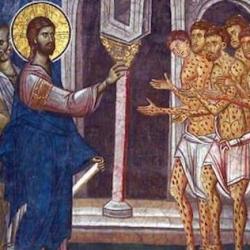Naomi Koltun-Fromm argues (Hermeneutics of Holiness) that the concepts of purity and holiness, while normally distinct in the Hebrew Bible, are blurred in some passages where qadash is used in contexts that speak of purity and purification rather than of consecration.
In 1 Samuel 21:6, David says that the “vessels” of the young men have been qodeshed, so they are qualified to eat qodesh bread. Koltun-Fromm explains that “By refraining from sexual intercourse for three days the men have not defiled themselves (or their clothing) with semen. In their present physically pure state they would be allowed to eat consecrated bread” (39).
Similarly, Moses is told to qadash the people before Yahweh appears on Sinai (Exodus 19:10, 14). Part of her argument for taking this as “purify” is syntactical: “Something that is to be sanctifi ed must be sanctifi ed to or for God. Here, God does not instruct Moses to ‘QDS the people to me (God)’ but, rather, just to ‘QDS them.’ Hence, the connotation must be ‘purify’—for all holy things belong to God. Sanctity in the biblical context cannot stand on its own” (39).
Besides, “the Israelites have already been sanctified by God (or will be in the future) when God declares that they ‘will be for me a holy nation [goy qadosh] and a kingdom of priests’ (Exod. 19:6). Hence, when God sends Moses down the mountain to prepare the people for their divine audience, that preparation entails purification, not sanctification. They prepare themselves in order to be able to withstand meeting God’s holiness (the source of all things holy) face to face. In order to survive such an encounter with the Holy, the people must purify themselves—that is, rid themselves of those things that God’s holiness finds anathema. In this case, the laundering of their clothing and the refraining from sexual relations is part and parcel of that purification process” (40).
Koltun-Fromm is correct to emphasize that purity in these texts involves sexual abstinence, and avoidance of semen-pollution. And her arguments for translating qadash as “purify” has some weight to it. But the arguments are not weighty enough to conclude that the distinction of “sanctify” and “purify” has been erased. In both passages, there are relevant contextual factors that explain the usage. David’s men are engaged in holy war, and thus have consecrated themselves in quasi-priestly fashion. If they were only pure, they would not be qualified to eat the showbread.
At Sinai, the Israelites are already designated as a “holy” people, but that status is a reason for consecration rather than a substitute for consecration. Israel’s encounter with Yahweh at Sinai is, further unique. After the tabernacle is erected, Israelites never encounter God directly, but only from courtyard, screened off by the veils of the tabernacle and the priests, living veils. Once those veils are in place, they don’t need to be consecrated to approach God – only purified.
So, it seems there are good reasons for the usages of these passages and no necessity to posit that qadash is used to refer to “purity.”
Koltun-Fromm is also unconvincing in her attempt to show the internal contradictions in the Torah’s concept of holiness. She summarizes her claim: “E and D posit that the people Israel are holy by virtue of their chosenness. P allows that only the priests are truly holy. And finally H offers the opportunity for all Israel to achieve holiness, but it must work at it for it is not a given. The ‘ritual’ and ‘moral’ purity paradigms discussed above come into play as they interact with these two notions of ascribed or achieved holiness. The pentateuchal redactor, in combining the various Torah traditions and harmonizing the narratives, leaves the theological differences side by side in uneasy coexistence” (41).
But why should this be considered “contradictory” rather than merely “complex.” The fact that all the people are holy in no way contradicts the claim that there are grades of holiness; the paradigm of “graded holiness” runs through the whole Torah. Further, there is no contradiction between holiness as a status and as an aspiration. We know what it means to say “Obama is the President” on his inauguration day, and we don’t think it contradicts the claim that “Obama became the President when US forces killed bin Ladin.” In the nature of the case, a status is not static; a status is an aspiration as much as a possession, achieved as much as conferred. That purity pertains to the land as well as the sanctuary is just what we’d expect from a people who inherits a “holy” land: Hence, no contradiction of P and H.















